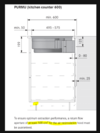Hello
Not sure if this is the right section.
In process of having new kitchen with island hob and it's an induction recirculating hob. The picture shows what I'm working with and I'm currently putting some ducting in to direct the airflow to the bottom of the units. It won't be a fully sealed tight fit, just trying to get it as good as possible. It's a Bora hob, requires 25mm clearance at back which we've got. I'm concerned about the exposed MDF and chipboard though. Would it be prudent to seal these?
Thanks
Not sure if this is the right section.
In process of having new kitchen with island hob and it's an induction recirculating hob. The picture shows what I'm working with and I'm currently putting some ducting in to direct the airflow to the bottom of the units. It won't be a fully sealed tight fit, just trying to get it as good as possible. It's a Bora hob, requires 25mm clearance at back which we've got. I'm concerned about the exposed MDF and chipboard though. Would it be prudent to seal these?
Thanks



